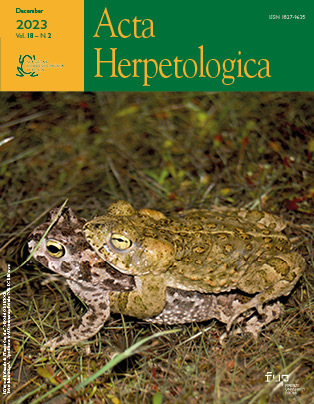Published 2023-12-27
Keywords
- Energy storage,
- post-hibernation,
- plateau brown frog,
- Tibetan plateau
How to Cite
Copyright (c) 2023 Xiao Fang Cheng, Wen Hao Shi, Hai Ying Li, Tong Lei Yu

This work is licensed under a Creative Commons Attribution 4.0 International License.
Funding data
-
National Natural Science Foundation of China
Grant numbers 31741019
Abstract
The energy storage plays a prominent part in the life histories of many animals inhabiting cold harsh environment, thus anuran amphibians rely on larger residual energy stores from post-hibernation to cope with unfavourable weather conditions before breeding. As the habitat conditions often change in different locations, selective pressure for energy storage could also vary. However, we still have limited knowledge on whether anurans living under different environmental backgrounds would adopt suitable strategies to cope with energy demands during reproduction. Here, we examined patterns of energy storage in spring (after hibernation and before reproduction) in seven plateau brown frog (Rana kukunoris) populations with different climatic conditions in the eastern Tibetan Plateau. After removing the effects of age and body size, liver weights of both sexes and fat body weights in males were negatively correlated with temperature, suggesting that these reserves were critical for this anuran to survive through harsh and extended dormancy period under uncertain environmental conditions. Additionally, reproductive investment in both sexes could partly explain the increase in post-hibernation energy stores with decreasing temperature. Males had relatively heavier liver and fat body weights than females, indicating that males store more energy reserves for breeding activity compared with females. Therefore, we suggest that both the variation of environmental conditions and sexual differentiation of reproductive roles play a prominent role in shaping the energy allocation and reserve patterns in the dormancy and breeding of amphibian species.
References
Chen, W., Wang, X., Fan, X. (2013): Do anurans living in higher altitudes have higher prehibernation energy storage? Investigations from a high-altitude frog. Herpetol. J. 23: 45-49.
Chen, W., Zhang, L.X., Lu, X. (2011a): Higher pre-hibernation energy storage in anurans from cold environments: a case study on temperate frog Rana chensinensis along broad latitudinal and altitudinal gradients. Ann. Zool. Fennici 48: 214-220.
Chen, W., Yu, T.L., Lu, X. (2011b): Age and body size of Rana kukunoris, a high-elevation frog native to the Tibetan plateau. Herpetol. J. 21: 149-151.
Elmberg, J. (1991): Ovarian cyclicity and fecundity in boreal common frogs Rana temporaria L. along a climatic gradient. Funct. Ecol. 5: 340-350.
Elmberg, J., Lundberg, P. (1991): Intraspecific variation in calling, time allocation and energy reserves in breeding male common frogs Rana temporaria. Ann. Zool. Fennici 28: 23-29.
Fitzpatrick, L.C. (1976): Life history patterns of storage and utilization of lipids for energy in amphibians. Am. Zool. 16:725-732.
Gasc, J.P., Cabela, A., Crnobrnja-Isailovic, J., Dolmen, D., Grossenbacher, K., Haffner, P., Lescure, J., Martens, H., Martinez Rica, J.P., Maurin, H., Oliveira, M.E., Sofianidou, T.S., Veith, M., Zuiderwijk, A. (1997): Atlas of amphibians and reptiles in Europe. Societas Europaea Herpetologica Museum National d’Histoire Naturelle, Paris.
Hijmans, R.J., Cameron, S.E., Parra, J.L., Jones, P.G., Jarvis, A. (2005): Very high resolution interpolated climate surfaces for global land areas. Int. J. Climatol. 25: 1965-1978.
Jönsson, I., Herczeg, G., O’Hara, R., Söderman, F., Ter Schure, A., Larsson, P., Merilä, J. (2009): Sexual patterns of prebreeding energy reserves in the common frog Rana temporaria along a latitudinal gradient. Ecography 32: 831-839.
Jönsson, K.I. (1997): Capital and income breeding as alternative tactics of resource use in reproduction. Oikos 78: 57-66.
Jørgensen, C.B., Larsen, L.O., Lofts, B. (1979): Annual cycles of fat bodies and gonads in the toad Bufo bufo bufo (L.), compared with cycles in other temperate zone anurans. Biol. Skri. 22: 5-37.
Jørgensen, C.B. (1981): Ovarian cycle in a temperate frog, Rana temporaria, with special reference to factors determining number and size of egg. J. Zool. 195: 449-458.
Lu, X. (2004): Annual cycle of nutritional organ mass in a temperate-zone anuran, Rana chensinensis, from northern China. Herpetol. J. 14: 9-12.
Lu, X., Li, B., Li, Y., Ma, X.Y., Fellers, G.M. (2008): Pre-hibernation energy reserves in a temperate anuran, Rana chensinensis, along a relatively fine elevational gradient. Herpetol. J. 18: 97-102.
Ma, X.Y., Lu, X., Merilä, J. (2009): Altitudinal decline of body size in a Tibetan frog. J. Zool. 279: 364-371.
McNamara, J.M., Houston, A.I. (1990): The value of fat reserves in terms of avoiding starvation. Acta Biotheor. 38: 37-61.
Niewiarowski, P.H. (2001): Energy budgets, growth rates, and thermal constraints: toward an integrative approach to the study of life-history variation. Am. Nat.157: 421-433.
Wells, K.D. (1977): The social behavior of anuran amphibians. Anim. Behav. 25: 666-693.
Wells, K.D. (2007): The ecology and behavior of amphibians. Chicago: University of Chicago Press.
Yu, T.L., Jia, G., Sun, H.Q., Shi, W.H., Li. X.L., Wang, H.B., Huang, M.R., Ding, S.Y., Chen, J.P., Zhang, M. (2022): Altitudinal body size variation in Rana kukunoris: the effects of age and growth rate on the plateau brown frog from the eastern Tibetan Plateau. Ethol. Ecol. Evol. 34: 120-132..
Yu, T.L., Lu, X. (2013): Body size variation of four latitudinally-separated populations of a toad species: age and growth rate as the proximate determinants. Integr. Zool. 8: 315-323.
Yu, T.L., Wang, D.L., Busam, M., Deng, Y.H. (2019): Altitudinal variation in body size in Bufo minshanicus supports Bergmann’s rule. Evol. Biol. 33: 449-460.
Yu, T.L., Han, Y.T., Zhang, S.P. (2016): Plasticity in metamorphic traits of Rana kukunoris tadpoles: The interactive effects of food level and rearing temperature. Russ. J. Ecol. 47: 552-556.
Yu, T.L., Li, H.J., Lu, X. (2013): Mating patterns of Rana kukunoris from three populations along an altitudinal gradient on the Tibetan Plateau. Anim. Biol. 63: 131-138.
Yu, T.L., Xu, Y., Busam, M., Deng, Y.H. (2018): Maternal investment decreases under stressful environments in 11 plateau brown frog (Rana kukunoris) populations. Ethol. Ecol. Evol. 30: 168-177.
Tong, L.Y., Li, H. Y., Chen, B. J., Chen, P. Z., Liu, X. R., Wang, Y. (2022): Geographic variation in reproductive investment of seven populations of male Brown frog (Rana kukunoris), endemic to the eastern Tibetan Plateau. Anim. Biol. 72: 245–256.





